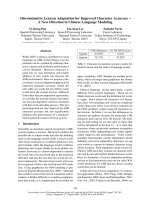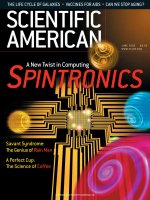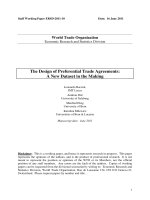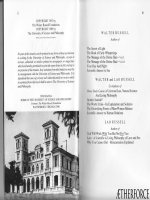Educational Triangular Pyramid A New Concept in Education
Bạn đang xem bản rút gọn của tài liệu. Xem và tải ngay bản đầy đủ của tài liệu tại đây (110.43 KB, 6 trang )
VNU Journal of Science: Education Research, Vol. 30, No. 4 (2014) 1-6
1
RESEARCH
Educational Triangular Pyramid:
A New Concept in Education
Trần Văn Nhung
*
ác
General Secretary of the State Council for Professor Promotion of Vietnam,
Former Vice-Minister of Education and Training of Vietnam, 7th Floor, Tạ Quang Bửu Library,
Hanoi University of Technology, No 1, Đại Cồ Việt Str., Hanoi, Vietnam
Received 26 May 2014
Revised 10 October 2014; Accepted 08 December 2014
Abstract: We believe that one of the most important tasks of education is to establish an organic
relationship between family, school, community/society and self-learning in educating a human
being as a citizen. In this article an attempt is made to use the concept of triangular pyramid in
elementary geometry to illustrate this relationship, emphasizing the fourth element, which is self-
learning. These four elements form a quadrilateral in the plane/two-dimensional space, or rather a
tetrahedron or a triangular pyramid in three-dimensional space. In fact, all these four elements,
their roles and the relationships between them in the process of education and training, and the
formation of a man, a citizen, have been studied since ancient time both in Viet Nam and overseas.
What is new here may be that the diagram indicating the relationship is illustrated by elementary
geometry, specifically by “educational triangular pyramid”. The main idea of this article is
derived from [5].
Keywords: Educational triangle, educational triangular pyramid, the relationship between family,
school, community/society and self-learning.
1. Educational Triangle
*
It has been known for years that three
factors family, school and community/society
(see, e. g., [1]) play a decisive role in the
formation and development of every human
being. These elements form the three sides of a
triangle with respective lengths as F, S, C (see
Figure 1) tentatively referred to as educational
triangle [5]. It should be added that the
_______
*
Tel.: 84-903431762
Email:
concepts of family, school and community
today has acquired extended connotations, new
meanings which are broader, deeper, and more
modern, because of the crossovers of cultures,
the strong influence of information technology
and the process of globalization.
It has been known for years that three
factors family, school and community/society
(see, e. g., [1]) play a decisive role in the
formation and development of every human
being. These elements form the three sides of a
triangle with respective lengths as F, S, C (see
T.V. Nhung / VNU Journal of Science: Education Research, Vol. 30, No. 4 (2014) 1-6
2
F = Family
S = School
C = Community
irregular
F
C S
F
S
C
Educational triangle
Figure 1) tentatively referred to as educational
triangle [5]. It should be added that the
concepts of family, school and community
today has acquired extended connotations, new
meanings which are broader, deeper, and more
modern, because of the crossovers of cultures,
the strong influence of information technology
and the process of globalization.
Tel.: 84-903431762
equilateral
Figure 1.
At each particular time t in a human life, 0
≤ t ≤ T (T stands for the life span of that
person), we set the length of the three sides of
the triangle by F(t), S(t) and C(t) respectively.
The impact of each of these elements on the
formation of a human being at time t is
different. Geometrically speaking, this triangle
is neverequilateral, that is, the lengths of the
three sides of the triangle at time t are not equal:
F(t) ≠ S(t) ≠ C(t) ≠ F(t) for all t on the time
interval [0,T]. At time t, when a child is at
home not yet in school, family affects her the
most, so the length of F(t) indicating the family
is the longest, F(t)> S(t)> C(t). When the child
goes to school, the school may influence him or
her more and more, and so the school side of
the triangle increases gradually, S(t) ↑, S(t)>
F(t), S(t)> C(t), and when the child goes to work,
and becomes a citizen, both the family and the
school sides of the triangle become shorter, giving
priority to the gradual influence of society, the
length of the society side C(t) increases gradually,
C(t) ↑, C(t)> F(t) , C(t)> S(t).
If we take the average in time along the
whole life from 0 to T of a normal person, to
put things simply, we can assume that the
educational triangle is equilateral; this does not
underestimate the role and responsibility of any
element or any side. Mathematically speaking,
if we take the average length of each side of the
triangle on time on [0,T], we have
F =
∫
T
0
F(t)
dt/T, S =
∫
T
0
S(t)
dt/T, C=
∫
T
0
C(t)
dt/T
And when the educational triangle is
normal, i.e., equilateral, the three sides are
equal, i.e., F=S=C.
In special cases, for special people, this
triangle is not equilateral. For example, there
are people who lost their parents after their
birth, and who have no relatives, the length of
the family side is considered close to zero, F(t)
≈ 0 for all t on [0,T]. There are people who
have never had a chance to go to school, have
never had any idea about school, are entirely
self-taught from family and society and yet
become good, successful, outstanding and even
great men. In this case, the length of the school
side is considered close to zero, S(t) ≈ 0 for all t
on [0,T], but
F(t))dt (C(t)
T
0
+
∫
≈ ∞.
Recently, when seeing that some students
do not behave decently, showing a decline
T.V. Nhung / VNU Journal of Science: Education Research, Vol. 30, No. 4 (2014) 1-6
3
ethics and conduct, many people in the society
and some parents put all the blame at the
school’s door, without realizing the influence,
the role and responsibility of themselves, of
family and of society. That is, accidentally or
intentionally they forget the role and
responsibility of the other two sides of the
equilateral educational triangle - the family and
the society sides. Is it fair and impartial to
blame only the school in this case? Surely, it is
not.It is not wrong to blame education, but
education should be understood in a broad
sense, as throughout his life, a man is educated
and is influenced equally from three directions
–the three sides of the equilateral triangle; i.e.,
family, school and society. It is better not to put
the blame on each other’s door, and family,
school and society should cooperate closely in
the process of forming a (global) citizen. A
harmonious and optimal cooperation will create
an optimal product.
2. Self-learning is very important
In 1996, based on the Report by Delors
(1988), UNESCO recommended that education
worldwide in the twenty-first century should be
built on four pillars, namely, "learning to
know, learning to work, learning to live
together and learning to be” [2,4,5]. All humans
acknowledge this truth. This can also be viewed
as the educational philosophy of the world,
including Vietnam, in the twenty-first century.
However, if we notice, we may realize that
basically this truth was raised by President Ho
Chi Minh in September, 1949 on the first page
of the golden book when he visited Nguyen Ai
Quoc Political Academy, the forerunner of the
current Ho Chi Minh National Academy of
Politics: "Learning to work, to be a man, and to
be a cadre. Learning to serve the unions, the
class and the people, the fatherland and the
humanity. If one wants to achieve that aim, one
should be industrious, economical, honest,
righteous, and impartial.”, cited in [3], p.684, or
[5]. I do not know whether this information has
reached UNESCO. If not, I suggest the Vietnam
National Committee of UNESCO send the
above-mentioned original autographs of Ho Chi
Minh with an English and French translation to
UNESCO in Paris to see how over half a
century ago Ho Chi Minh contributed to
building up the four pillars of education
worldwide as recommended by the UNESCO in
1996. By the way, I would also suggest that the
Vietnam National Committee of UNESCO, in
introducing our tangible and intangible heritage
to UNESCO for recognition, which we have
been doing very well, should pay more
attention to the introduction of the ideological
and cultural heritage of our Vietnamese people
in general and of our Uncle Ho in particular, of
which the above example is just a specific one.
This is because ideological and cultural heritage
of each nation is no less important than tangible
one created and left by "nature".
The concepts of "self-learning" and
"lifelong learning" are proposed by UNESCO
and need to be understood in a broad sense, in
its full meaning; that is to say, in self-learning
one continues to learn not only knowledge but
also culture, ethics, and life skills throughout
their life. It is the fourth element, the element of
self-learning or self-osmosis that facilitates the
three other ones (i.e. learning from family,
learning from school and learning from society)
to be maximized informing a full human being.
Self-education is even more important and
more decisive than the education one
receives from family, school and society. The
fact that some people are better than others is
due to this self-learning ability. The distinction
between two children in the same family (or
even between twins), two students in the same
T.V. Nhung / VNU Journal of Science: Education Research, Vol. 30, No. 4 (2014) 1-6
4
class, or two citizens in the same community,
depends first and foremost on their ability, on
the genetics of the individuals, and then it
depends very much on their self-learning, self-
osmotic, self-adjusting, self-adaptive, and self-
improving ability.
The same is true in the plant world: Two
identical seedlings, grown on the same plot of
land, receive the same amount of fertilizer and
water, breathe the same volume of air (oxygen
and carbon dioxide), and receive the same
amount of sunlight, but the tree that performs
better metabolism, higher photosynthetic
efficiency will grow faster and more strongly,
will be less prone to pests, and will adapt itself
to external conditions better.
3. Educational Triangular Pyramid
Figure 2.
We think that the element of “self-
learning” should be emphasized and added to
the diagram to illustrate the process of human
education, i.e., the educational triangle as
mentioned above. For ease of visualization, we
see that vertex four, vertex self-learning (self-
osmosis, self-perfection), denoted by L, along
with the three sides of the base triangle FSC -
family, school and community/society, form the
triangular pyramid LFSC in the three-
dimensional space, like the space we are living,
which can be tentatively referred to as the
educational triangular pyramid (see Figure
2).To put things simply, a triangular pyramid is
a tetrahedron having a top and a bottom which
is a triangle. Its three side faces are triangles.
We can think that this may be a full illustration
of the relationship between the four elements of
education to form a full human being. The
study of the change in the form and lengths of
the six sides and the areas of the four faces of
this educational triangular pyramid with top L
over time on [0,T] can also be done in the same
way for the educational triangle FSC. The “self-
learning” vertex L of the educational triangular
pyramid LFSC lies over the base educational
triangle FSC. The forms and areas of the three
side faces indicate the self-learning and self
perfection ability of each individual being
influenced by family, school and
community/society.
At each time in a man's life, the triangular
pyramid LFSC is not regular, i.e., its four faces
are four irregular and unequal triangles. But if
we take the average life time on the segment
[0,T] of a normal human, to put things simply,
we can assume this educational triangular
pyramid as regular, i.e., its base is an equilateral
triangle and its three sides are equal. Then the
base triangle FSC and the three side faces of this
pyramid are equilateral and equal. We should not
overlook any vertex, any side, and any face.
The shape and the size of this triangular
pyramid are, in fact, constantly changing over
L = Self-Learning
F = Family
S = School
C = Community
Educational triangular pyramid
d
ụ
c
L
F
S
C
h
S
C
F
L
h
regular
irregular
T.V. Nhung / VNU Journal of Science: Education Research, Vol. 30, No. 4 (2014) 1-6
5
time during the life of a man on the segment
[0,T]. It is tied to a particular person to
characterize the maturity process and the
capability of that person. We denote the
capacity of self-learning of each person by
height h of self-learning vertex L on the base
triangle FSC. The better the self-learning ability
of a person, the higher the self-learning vertex,
and vice versa. With abnormal people, for
example, with the very incompetent ones, h is
very small, h ≈ 0, or even h = 0, that is, they
have absolutely no ability to learn. As for
genius or great people, the educational
triangular pyramid is no longer regular; it is
even very "singular" or "strange": the vertex L
on the bottom triangle FSC can move upward to
infinity, h → ∞. So h varies in human life from
0 to ∞, 0 ≤ h ≤ ∞.
As has been known in elementary
geometry, volume V of the triangular pyramid
LFSC is calculated by the formula V=Bh/3,
where B is the area of the base triangle FSC and
h is the height of the pyramid, i.e., the distance
from vertex L to the base FSC. We want to use
the magnitude of the volume V of the
educational triangular pyramid to denote the
ability, the learning and research capacity, and
the growth of each human being. When the area
of the base triangle FSC (the conditions and
educational influences from family, school and
community/society) is temporarily fixed and
denoted by B, then the only way to increase the
volume V of the pyramid is to find ways to
increase its height h, finding all ways to
maximize the value of the parameter h, i.e.,
maximizing the spirit, the will, the method and
the efficiency of self-learning, self-osmosis,
self-striving, and self-perfection of each person.
In human beings, h can vary from 0 to ∞ and V
may also vary from 0 to ∞. For those who are
incompetent, V ≈ 0, while for genius or great
people, V → ∞, V ≈ ∞.
Thus, the important and noble but most
difficult task or mission for the teacher and
education is to "inspire" students so as to
transform the process of “being educated” into
that of self-education and self-learning, i.e.,
maximizing the self-learning height h of each
human being. As Anatole France once said:
"Nine tenths of education is encouragement".
And in the same vein, William A. Ward
maintained: “The mediocre teacher tells. The
good teacher explains. The superior teacher
demonstrates. The great teacher inspires”.
4. One is still unwise even when he or she is
old, there is still something more to learn
Before concluding this paper, I would like
to tell a short story that has obsessed me. About
five years ago, when I was flying from Tan Son
Nhat Airport (Ho Chi Minh City) to Hanoi, I
saw a foreigner walking to the stairs for
boarding. He was pulling a suitcase and was
about 10 meters in front of me. Suddenly I saw
him slip, stagger and almost fall his head onto
the floor. He looked very frustrated, and he
muttered something.Walking closer to him to
see what was happening, I saw a slippery
puddle where he had almost stumbled. I
discovered that there was an air conditioner
over our heads which was broken down, and it
was dropping water on the ground. Realizing
that it was the fault of our airport, I apologized
to the foreigner for that. He smiled and said,
“It’s OK”. While I was approaching an airport
staff to ask him to fix the air conditioner, the
foreigner took a chair nearby and placed it on
the slippery puddle as a signal to show the
passengers behind him so that they would not
fall off.Thus, the work the foreigner had done
was more agile, more effective, and more
humanitarian than mine. The chair he had put
on the puddle as an obstacle could help the
passengers behind to avoid falling off onto the
ground which might cause injuries, and at the
same time it was a reminder to tell the airport
staff to quickly fix the air conditioner; while I
T.V. Nhung / VNU Journal of Science: Education Research, Vol. 30, No. 4 (2014) 1-6
6
had done only one thing - "to transfer duty" to
the airport staff, and it was likely that a few
seconds or a few minutes later someone would
fall off onto the ground and would be seriously
injured, because the air conditioner was not yet
fixed. Well, one is still not wise enough even
when he or she is old, there are still more life
skills or soft skills one needs to learn! Human
culture is so deep and so vast!
Conclusion: Family + School +
Community/Society + Self-Learning = Full
human being.
The author would like to thank Prof. Dr.
Hoang Van Van, Assoc. Prof. Dr. Nguyen Minh
Man, Assoc. Prof. Dr. Nguyen Huu Bach,
Assoc. Prof. Dr. Phung Quoc Tuan and Mr.
Nguyen Duc Huy (MSc) for reading the
manuscript and making invaluable comments
on this paper.
References
[1] Epstein, J. L., L. Coates, K. C. Salinas, M.G.
Sanders, and B. S. Simon: School, Family, and
Community Partnerships. Your Handbook for
Action. Thousand Oaks, California: Corvin
Press, Inc, 1997.
[2] Delors, J., Learning: The Treasure Within,
Report to UNESCO of the International
Commission on Education for the Twenty-first
Century. UNESCO Publishing 1998, ISBN
9231034707, 9789231034701. See also the
Vietnamese translated version by Trinh Duc
Thang, Vu Van Tao (Ed.), 2002.
[3] Hồ Chí Minh Collection (12 Volumes), see
Volume 5 (1947-1949), p.684; the State
Political Publishing House, Hanoi-2004 (in
Vietnamese).
[4] Pham Minh Hac: Vietnam Education at the turn
of the 20
th
Century, the State Political
Publishing House, Hanoi-1999 (in Vietnamese).
[5] Trần Văn Nhung: Some Notes on Education
and Training, Vietnam Education Publishing
House, Hanoi-2011 (in Vietnamese).
Hình chóp tam giác giáo dục:
Một khái niệm mới trong giáo dục
Trần Văn Nhung
á
Tổng Thư ký Hội đồng Chức danh giáo sư nhà nước, Nguyên Thứ trưởng Bộ Giáo dục và Đào tạo,
Tầng 7, Thư viện Tạ Quang Bửu, Trường ĐHBK Hà Nội, Số 1, Đại Cồ Việt, Hà Nội, Vietnam
Tóm tắt: Chúng tôi cho rằng một trong những việc làm quan trọng nhất của giáo dục là xây dựng
được mối quan hệ hữu cơ giữa gia đình, nhà trường, cộng đồng/xã hội và việc tự học trong việc đào
tạo một con người, một công dân. Vì vậy trong bài viết này chúng tôi thử dùng khái niệm hình chóp
tam giác trong hình học sơ cấp để minh họa cho mối liên hệ này, trong đó nhấn mạnh yếu tố thứ tư, đó
là tự học. Bốn yếu tố này tạo thành bốn đỉnh của một tứ giác trên mặt phẳng/không gian hai chiều, hay
đúng hơn là một khối tứ diện hoặc một hình chóp tam giác trong không gian ba chiều. Thực ra cả bốn
yếu tố, vai trò và quan hệ giữa chúng trong quá trình giáo dục, đào tạo và hình thành một con người,
một công dân, đã được nói đến và nghiên cứu nhiều từ xưa cho đến nay ở trong và ngoài nước. Cái
mới ở đây có chăng chỉ là sự minh họa sơ đồ quan hệ bằng hình học sơ cấp, cụ thể là bằng hình ảnh
"hình chóp tam giác giáo dục". Ý tưởng chính của bài viết này được bắt nguồn từ [5].
Từ khóa: Tam giác giáo dục, hình chóp tam giác giáo dục, mối liên hệ giữa gia đình, nhà trường,
cộng đồng/xã hội và việc tự học.
TổnhTllc









